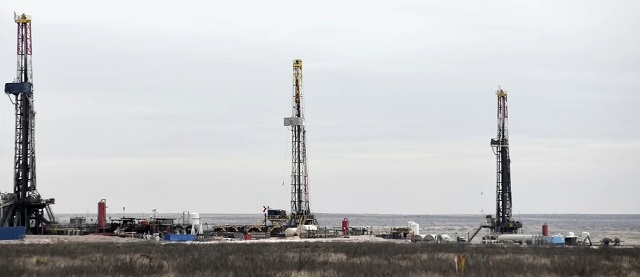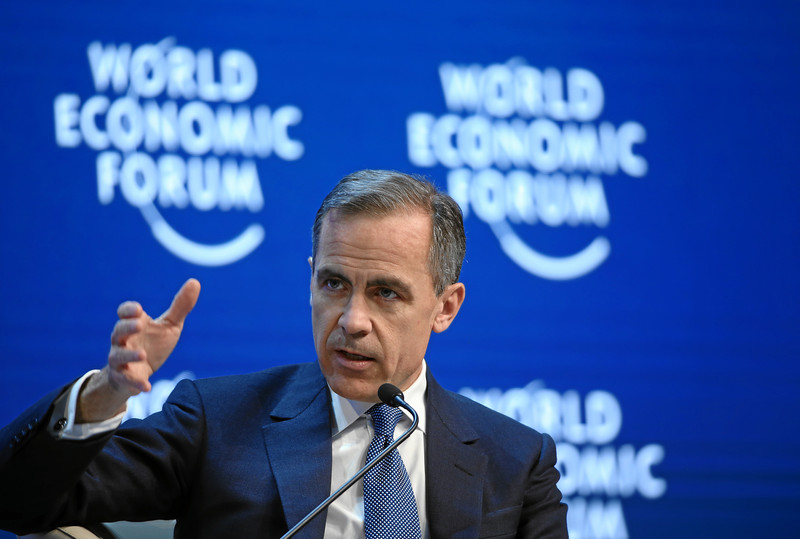Energy
Energy Companies May Be On Cusp Of Uncorking Next Massive Oil, Gas Boon

 From the Daily Caller News Foundation
From the Daily Caller News Foundation
These companies, all run by smart business people, continue to invest many billions of capital dollars in these risky, long-term projects even as “experts” like the bureaucrats at the International Energy Agency (IEA) continue to predict demand for crude oil is about to peak in the next few years.
Constantly advancing technology has always been the driver behind the advance of the oil-and-gas industry since the first successful U.S. well was drilled by Edwin Drake near Titusville, Pennsylvania, in 1859. The Drake well was drilled to a then unheard-of depth of 69 feet using the most primitive equipment imaginable.
This week, 165 years later, U.S. oil giant Chevron announced it had achieved first production in its Anchor field in the Gulf of Mexico. At its shallow depth, underground pressure in the Drake well would have been negligible, just enough to force the oil up out of the ground. The Anchor semi-submersible floating production unit (FPU) that was started up by Chevron this week enables the capture of massive volumes of oil and natural gas from underground formations up to 34,000 feet below sea level at pressures up to 20,000 pounds per square inch.
“The Anchor project represents a breakthrough for the energy industry,” said Nigel Hearne, executive vice president, Chevron Oil, Products & Gas. “Application of this industry-first deepwater technology allows us to unlock previously difficult-to-access resources and will enable similar deepwater high-pressure developments for the industry.”
Chevron says seven deepwater wells will be tied into the Anchor FPU, which has the capacity to capture, process and transport as much as 75,000 barrels of oil and 28 million cubic feet of natural gas every day. The company estimates reserves in the field of 440 million barrels of oil equivalent with current technology. But, again, the technology deployed by the industry advances every day, meaning a far bigger amount of oil and gas will ultimately be recovered over the coming years.
Other major oil companies, like BP, are also beginning to deploy similar high-pressure technology that they and analysts believe will help them tap into billions of new barrels known to exist in deep, high-pressure formations in various parts of the world. Globally, BP says it believes deployment of advanced technology could help it access up to 10 billion barrels of known high pressure reserves.
Reuters quotes Wood Mackenzie principal analyst Mfon Usoro as saying the new high pressure technologies could enable companies like BP and Chevron to unlock as much as 2 billion barrels of known reserves in the Gulf of Mexico alone. “The industry has done their bit to safely deliver the barrels, with the new technology,” she said, adding: “These ultra-high-pressure fields are going to be a big driver for production growth in the Gulf of Mexico.”
On the same day Chevron made its announcement, Chinese national oil company CNOOC announced the completion of what it believes is the largest offshore platform on Earth, the Marjan facility. The giant platform, which serves similar functionality as the Anchor FPO, will now be shipped 6,400 nautical miles to the Persian Gulf, where it will facilitate the full development of Saudi Arabia’s deepwater Marjan Field.
It is important to keep in mind that the mounting of these massive offshore facilities and drilling of the deepwater wells are all long-term, multi-billion-dollar projects. These are facilities designed to handle the production from these deepwater fields for decades, not just a few years until the vaunted energy transition takes away all the demand for the commodities being produced.
In addition to the projects in the Gulf of Mexico and Persian Gulf, all the companies mentioned here are involved in aggressive efforts to discover and produce oil and gas in deepwater regions around the world. CNOOC, for example, is a 20% owner in the prolific Stabroek block development offshore of Guyana operated by ExxonMobil. Chevron stands to become a 30% owner in that same development via its proposed buyout of Houston-based Hess Corp.
These companies, all run by smart business people, continue to invest many billions of capital dollars in these risky, long-term projects even as “experts” like the bureaucrats at the International Energy Agency (IEA) continue to predict demand for crude oil is about to peak in the next few years. Meanwhile, OPEC says it believes demand for crude will keep rising through at least 2045, perhaps longer.
Someone will be right, and someone will be wrong. Regardless, we can rest assured that advancing technology in the industry itself will ensure there will be no shortage of supply.
David Blackmon is an energy writer and consultant based in Texas. He spent 40 years in the oil and gas business, where he specialized in public policy and communications.
Featured image credit: (Screen Capture/PBS NewsHour)
Daily Caller
‘Drill, Baby, Drill’ Or $50 Oil — Trump Can’t Have Both


From the Daily Caller News Foundation
By David Blackmon
President Donald Trump has often made clear his goal of cutting prices for energy as part of his overall agenda to break the back of chronic inflation left behind by the Biden presidency. When talking about this goal, the president has placed special emphasis on lowering the price of crude oil, given its integral relationship to gas prices at the pump and transportation-related costs which go into the price of food, clothing and other consumer goods.
“A very big thing that I’m very happy with is oil is down,” Trump said in remarks in the Oval Office on Wednesday. “We’re getting that down. When energy comes down, prices are going to be coming down with it. So, in a very short period of time, we’ve done a very good job.”
White House advisor Peter Navarro has been quoted by The New York Times and other media outlets as saying that an average oil price of $50 per barrel would help tame inflation and set the stage for a return to a healthier economy. If that is indeed the goal, this week’s confluence of events, featuring a bigger-than-expected increase in oil production quotas from the OPEC+ oil cartel preceded less than 24 hours earlier by the president’s announced reciprocal tariffs on a wide array of countries went a long way to doing the trick.
Just prior to Trump’s tariff announcement Wednesday afternoon, the price for West Texas Intermediate crude stood at $70/bbl. Less than 48 hours later, the price had fallen below $61, a drop of about 15%. It was the largest 2-day decline in crude prices since 2021. How much of the price decrease is due to the tariffs as opposed to the OPEC+ agreement to pour another 137,000 barrels per day onto the international market is hard to know, but there is no doubt both actions had an impact.
As I’ve noted previously, this action to force lower prices for oil and natural gas lies directly at odds with the concurrent Trump “drill, baby, drill” objective which he sees as a key part of his American Energy Dominance agenda. The White House gave a nod to the oil refining segment in the Wednesday tariff announcement by exempting energy imports, another action at least in part aimed at lowering prices for gasoline and diesel fuel.
But that nod to the downstream segment does little for upstream companies who have seen supply chain muck-ups and Biden-era inflation raise break-even prices above Friday’s levels. The Q1 2025 Energy Survey Report published March 26 by the Dallas Federal Reserve estimates that drillers in the Permian Basin require a $61 oil price just to break even on drilling new shale wells. The needed breakeven price rises higher in other, less prolific basins. CNN quoted independent oil analyst Andy Lipow as saying that many upstream companies require prices closer to Monday’s $71/bbl level for new shale wells. It almost goes without saying that operators will have little incentive to “drill, baby, drill” if they stand to lose money doing it.
In an interview with Fox Business host Stu Varney on Tuesday, Energy Secretary Chris Wright, himself a former oil industry executive, said, “If your state has expensive energy, it’s because of choices made by politicians in those states to virtue signal somehow they’re on some global mission. They’re going to solve climate change by making your utility bills more expensive and your businesses want to relocate out of the states. That’s just nonsense.” He added that Trump was pursuing energy policies based on common sense, saying, “common sense will deliver more investment in our country and lower energy prices.”
No doubt, few executives in the industry would agree that a pursuit of $50 oil prices has anything to do with common sense for their companies. If prices should drop that far and linger there for any length of time, layoffs and idled drilling rigs will become the prevailing topic of the day in oil and gas.
So, while the White House might continue touting its “drill, baby, drill” slogan for the time being, we won’t hear it echoing through the barbecue and Tex-Mex joints in Midland, Texas, for the time being.
David Blackmon is an energy writer and consultant based in Texas. He spent 40 years in the oil and gas business, where he specialized in public policy and communications.
2025 Federal Election
Poilievre To Create ‘Canada First’ National Energy Corridor

From Conservative Party Communications
Poilievre will create the ‘Canada First’ National Energy Corridor to rapidly approve & build the infrastructure we need to end our energy dependence on America so we can stand up to Trump from a position of strength.
Conservative Leader Pierre Poilievre announced today he will create a ‘Canada First’ National Energy Corridor to fast-track approvals for transmission lines, railways, pipelines, and other critical infrastructure across Canada in a pre-approved transport corridor entirely within Canada, transporting our resources within Canada and to the world while bypassing the United States. It will bring billions of dollars of new investment into Canada’s economy, create powerful paycheques for Canadian workers, and restore our economic independence.
“After the Lost Liberal decade, Canada is poorer, weaker, and more dependent on the United States than ever before,” said Poilievre. “My ‘Canada First National Energy Corridor’ will enable us to quickly build the infrastructure we need to strengthen our country so we can stand on our own two feet and stand up to the Americans.”
In the corridor, all levels of government will provide legally binding commitments to approve projects. This means investors will no longer face the endless regulatory limbo that has made Canadians poorer. First Nations will be involved from the outset, ensuring that economic benefits flow directly to them and that their approval is secured before any money is spent.
Between 2015 and 2020, Canada cancelled 16 major energy projects, resulting in a $176 billion hit to our economy. The Liberals killed the Energy East pipeline and passed Bill C-69, the “No-New-Pipelines” law, which makes it all but impossible to build the pipelines and energy infrastructure we need to strengthen the Canadian economy. And now, the PBO projects that the ‘Carney cap’ on Canadian energy will reduce oil and gas production by nearly 5%, slash GDP by $20.5 billion annually, and eliminate 54,400 full-time jobs by 2032. An average mine opening lead time is now nearly 18 years—23% longer than Australia and 38% longer than the US. As a result of the Lost Liberal Decade, Canada now ranks 23rd in the World Bank’s Ease of Doing Business Index for 2024, a seven-place drop since 2015.
“In 2024, Canada exported 98% of its crude oil to the United States. This leaves us too dependent on the Americans,” said Poilievre. “Our Canada First National Energy Corridor will get us out from under America’s thumb and enable us to build the infrastructure we need to sell our natural resources to new markets, bring home jobs and dollars, and make us sovereign and self-reliant to stand up to Trump from a position of strength.”
Mark Carney’s economic advice to Justin Trudeau made Canada weaker while he and his rich friends made out like bandits. While he advised Trudeau to cancel Canadian energy projects, his own company spent billions on pipelines in South America and the Middle East. And unlike our competitors Australia and America, which work with builders to get projects approved, Mark Carney and Steven Guilbeault’s radical “keep-it-in-the-ground” ideology has blocked development, killed jobs, and left Canada dependent on foreign imports.
“The choice is clear: a fourth Liberal term that will keep our resources in the ground and keep us weak and vulnerable to Trump’s threats, or a strong new Conservative government that will approve projects, build an economic fortress, bring jobs and dollars home, and put Canada First—For a Change.”
-

 2025 Federal Election17 hours ago
2025 Federal Election17 hours agoMark Carney refuses to clarify 2022 remarks accusing the Freedom Convoy of ‘sedition’
-

 2025 Federal Election21 hours ago
2025 Federal Election21 hours agoPoilievre To Create ‘Canada First’ National Energy Corridor
-

 Bruce Dowbiggin19 hours ago
Bruce Dowbiggin19 hours agoAre the Jays Signing Or Declining? Only Vladdy & Bo Know For Sure
-

 2025 Federal Election20 hours ago
2025 Federal Election20 hours agoFixing Canada’s immigration system should be next government’s top priority
-

 Daily Caller18 hours ago
Daily Caller18 hours agoBiden Administration Was Secretly More Involved In Ukraine Than It Let On, Investigation Reveals
-

 2025 Federal Election2 days ago
2025 Federal Election2 days agoCanada Continues to Miss LNG Opportunities: Why the World Needs Our LNG – and We’re Not Ready
-

 Health2 days ago
Health2 days agoSelective reporting on measles outbreaks is a globalist smear campaign against Trump administration.
-

 2025 Federal Election2 days ago
2025 Federal Election2 days agoMark Carney is trying to market globalism as a ‘Canadian value.’ Will it work?


